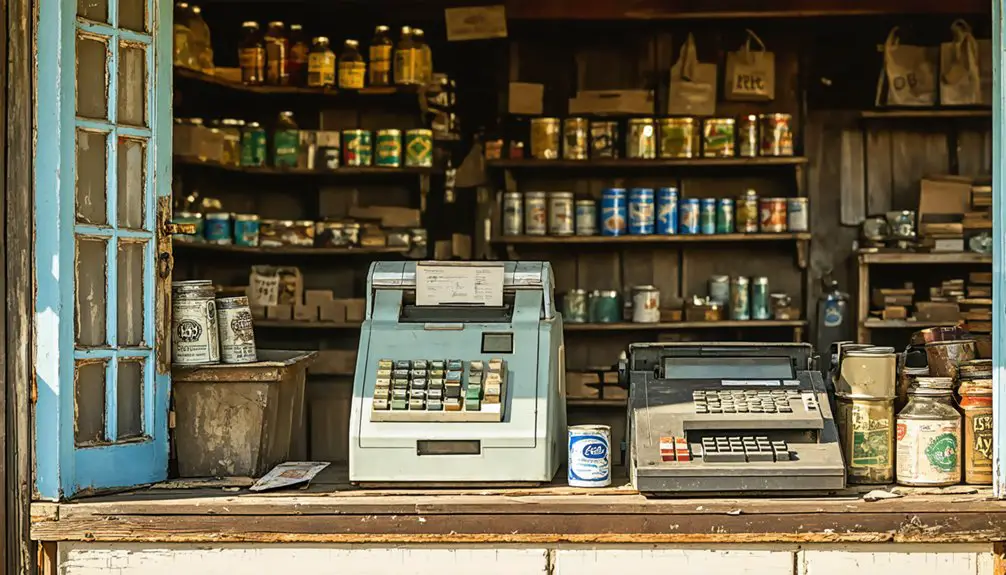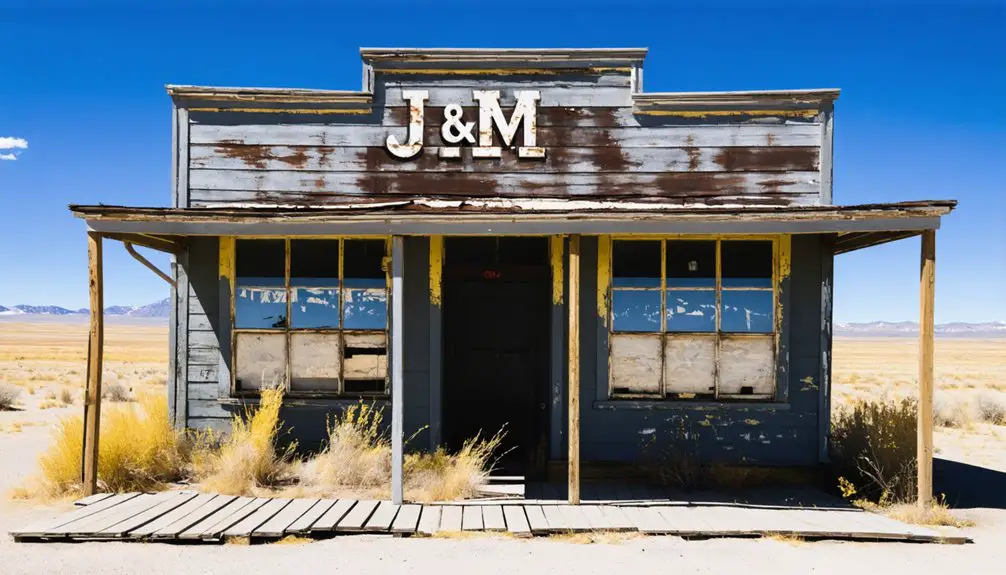You’ll find Jay Em nestled along Wyoming’s historic Cheyenne-Deadwood Stage Road, where James Moore established his ranch in 1869 with the “J Rolling M” brand. The settlement grew from a Texas Trail watering hole into a bustling commercial center, featuring a general store, lumber yard, and blacksmith shop by the 1920s. While only three residents remained by the 1980s, Jay Em’s well-preserved buildings still tell fascinating stories of Wyoming’s frontier era.
Key Takeaways
- Jay Em began as a successful ranch in 1869, evolved into a trading post by 1919, and became a thriving ranching community hub.
- The town featured eight commercial buildings, including a general store, lumber yard, blacksmith shop, and bank during its peak years.
- Community life centered around the 1935 general store hall, which hosted social gatherings, Sunday school, and dances.
- Jay Em declined in the late 1930s due to failed dry farming practices, leading to business closures and population loss.
- By the 1980s, the once-bustling ranching town became a ghost town with only three residents remaining.
The Legacy of James Moore’s Ranch
When James Moore and his brother Charles established their ranch along Rawhide Creek in 1869, they laid the foundation for one of Wyoming Territory’s most significant cattle operations.
Under their leadership, the “J Rolling M” brand became synonymous with frontier success as they expanded holdings into Nebraska and Colorado. Moore demonstrated the same determination in ranching as during his days as a Pony Express rider.
The J Rolling M brand epitomized Western achievement, growing from Wyoming roots into a multi-state ranching powerhouse.
You’ll find Moore’s influence deeply embedded in the region’s identity, from the naming of Jay Em Creek to the town that would later bear his brand’s phonetic spelling. Their operation benefited from its position along the historic Cheyenne-Deadwood Stage Road.
Though Moore’s ranch management lasted only six years before his death in 1875, his legacy lived on when Rensselaer Schuyler Van Tassell acquired the property, followed by the Harris family’s Jay Em Cattle Company.
The ranch’s strategic location and cattle branding heritage sparked the development that would transform this stretch of Rawhide Creek into a thriving community.
From Watering Hole to Trading Post
You’ll find the origins of Jay Em at an essential watering hole along Rawhide Creek, where James Moore’s cattle operation first took root in 1869 with his distinctive “J Rolling M” brand.
When Silas Harris took over the ranch in 1905, he established initial community services including a general store and post office to serve the growing number of homesteaders.
Lake Harris’s vision transformed the site from a simple ranch outpost into an official trading post by 1919, complete with ambitious plans for an eight-block town that would support the surrounding ranching communities without relying on railroads. The town developed into a vital hub with eight commercial buildings that served as the backbone of local business activity. The weekly Jay Em Sentinel newspaper helped establish the town as a regional commerce center from 1917 to 1921.
Early Ranch Settlement History
At the heart of Jay Em’s origins lies a natural watering hole along the historic Texas Trail in Goshen County, where James Moore, a former Pony Express rider, staked his claim in the 1860s.
You’ll find that Moore’s entrepreneurial spirit led him to establish one of Wyoming Territory’s largest cattle ranching operations by 1869, making strategic use of the water source for cattle drives and daily operations.
Moore’s legacy lives on through his “J Rolling M” brand, which gave Jay Em Creek its name.
After his death in the 1870s, the Harris family took control of the ranch in 1905, bringing ranching innovations and crucial services to the area.
Lake Harris established the post office in 1905 within the Jay Em Ranch bunkhouse.
They transformed the simple watering hole into a crucial trading post, adding a general store and post office to serve the growing ranching community.
Town’s Commercial Evolution
The transformation of Jay Em from a simple watering hole into a planned service town began taking shape between 1912 and 1915 under Lake C. Harris’s vision.
You’ll find that this commercial transformation wasn’t just about building structures – it created a crucial hub for the region’s scattered ranching community.
The town’s trading post function centered around its general store, which doubled as a social gathering spot with Saturday night dances on its upper floor.
You could find everything from groceries to banking services, while the post office kept settlers connected to the outside world.
The Farmers State Bank opened in 1920, providing essential financial services to the growing community.
In 1935, the town expanded its retail options with the addition of a new grocery store and stone shop.
This development marked Jay Em’s evolution from a primitive stopover to an indispensable commercial center, though its prominence would later fade with the post office’s closure in 1991.
Peak Years of a Ranching Hub
During the 1920s and 1930s, Jay Em flourished as northern Goshen County’s premier ranching hub, offering crucial services to the region’s scattered ranching community.
You’d find ranching innovations throughout the area, with the Jay Em Ranch managing over 150 paddocks across 34,000 acres for diverse livestock operations. The ranch’s location between the North Platte River valley and Niobrara River headwaters provided ideal conditions for cattle grazing.
The town’s economic resilience showed in its thriving businesses – a general store, lumber yard, blacksmith shop, and the Farmer’s State Bank established in 1920.
Lake Harris’s post office served as a crucial communication center, while the Jay Em Stone Company, founded in 1935, brought new industry to the area.
The town’s strategic location along Rawhide Creek and Jay Em Creek headwaters made it ideal for supporting the region’s extensive cattle operations.
Architecture and Historic Buildings
Walking through Jay Em’s commercial district today, you’ll find a remarkable collection of early 20th-century buildings that showcase practical, vernacular architecture typical of Wyoming’s rural communities.
The architectural significance lies in the town’s authentic wood-frame structures with ship-lap siding and concrete foundations, crowned by distinctive gambrel and gabled roofs. With only a handful of residents remaining, these historic structures stand as silent witnesses to a bygone era.
Jay Em’s wood-frame buildings, featuring ship-lap siding and concrete foundations, epitomize Wyoming’s early rural architecture with their distinctive rooflines.
You can explore the building materials and craftsmanship that defined this ranching hub through:
- The two-and-a-half story Restaurant-Feed Store complex with its commanding gambrel roof
- The lumber yard’s false-front facade, creating an imposing commercial presence
- The Stone Company’s two-story brick building, where artisans once crafted marble and onyx works
These closely-clustered commercial structures, built between 1915 and 1935, stand as evidence of Lake Harris’s vision for a self-sufficient ranching community.
Community Life in Early Jay Em

You’d find the heart of Jay Em’s social life in the dance hall above the general store, where ranch families gathered for weekend celebrations and community dances.
Ranch families would travel for miles across the Wyoming plains to attend these cherished social events, often staying overnight with friends or relatives.
These gatherings served as essential connection points for isolated homesteaders and ranchers, offering rare opportunities for socializing, courtship, and sharing news in southeastern Wyoming’s vast landscape.
Dancing Above General Store
While many frontier towns struggled to establish social spaces, Jay Em’s general store, built in 1935, featured a spacious hall above that became the heart of community life.
You’d find homesteaders and ranchers gathering there for dance traditions that helped break the isolation of frontier living. The hall wasn’t just for dancing – it served multiple crucial community functions. In earlier years, the Farmers State Bank occupied the building before its sale in 1945.
- Sunday school and church club meetings strengthened spiritual bonds
- Dance events created opportunities for courtship and celebration
- Apartment spaces provided housing, blending residential and social life
The hall’s versatility proved indispensable in a town without formal civic buildings, and you can still imagine the sounds of boots on wooden floors as neighbors came together, forging connections that would help them survive the challenges of Wyoming’s frontier life.
Ranch Family Social Events
Despite the vast distances between homesteads, ranch families in early Jay Em maintained vibrant social connections through seasonal gatherings that punctuated the ranching calendar. You’d find neighbors coming together during branding time and harvest, sharing meals and news while tackling essential ranch work.
These gatherings weren’t just about getting jobs done – they strengthened community bonding through storytelling, music, and shared traditions centered around the Jay Em Cattle Company’s operations.
When ranch families weren’t cooperating on chores, they’d gather for picnics near Rawhide Creek, attend community dances, or celebrate holidays together. While trips to town for supplies at the general store or post office created natural meeting points, these planned social events gave isolated families significant opportunities to preserve their cultural heritage and maintain lasting relationships.
The Path to Abandonment
Although Jay Em began with promise as a service town for local ranchers in 1912, its path toward abandonment started taking shape in the late 1930s when dry farming practices failed throughout the region.
This failure triggered a chain reaction that devastated the town’s economic sustainability, forcing many residents to seek opportunities elsewhere through rural migration.
You can trace Jay Em’s decline through these pivotal events:
- The collapse of dry farming led to a sharp reduction in ranching support services
- Essential businesses and the post office gradually shuttered their doors
- By the late 1980s, the population had dwindled to just three residents
What you’ll find today is a ghost town, where empty buildings stand as silent witnesses to the broader pattern of Wyoming’s rural depopulation and changing ranch practices throughout the 20th century.
Preserving Wyoming’s Rural Heritage
Since Wyoming’s rural heritage faces ongoing preservation challenges, multiple government agencies and community organizations have joined forces to protect the state’s historic treasures.
You’ll find the State Historic Preservation Office working alongside the Bureau of Land Management and local governments to safeguard over 8,000 cultural resources spanning 10,000 years of history.
Through rural preservation efforts, you can explore more than 500 historical monuments and 20 state historic sites that showcase Wyoming’s unique past.
Wyoming’s preservation initiatives protect hundreds of historic monuments and sites, offering visitors glimpses into the state’s fascinating cultural heritage.
The state’s commitment to heritage education is evident in its distribution of over $32 million in federal grants since 1965.
Local property owners and community groups play an essential role too, partnering with agencies to maintain historic sites and develop educational programs that keep Wyoming’s rich rural legacy alive for future generations.
Frequently Asked Questions
What Wildlife Can Visitors Commonly Spot Around Jay Em Today?
You’ll find local fauna including pronghorn, mule deer, coyotes, and various bird species, with rare wildlife sightings of Pinyon Jays in the juniper woodlands and rattlesnakes in rocky areas.
Are There Any Reported Ghost Stories or Supernatural Occurrences in Jay Em?
You won’t find documented ghost sightings or haunted history here – unlike many other Western ghost towns, there aren’t any widely reported supernatural occurrences or spooky legends in the historical records.
What Was the Highest Recorded Population of Jay Em?
You’ll find that this ghost town’s history reached its peak with more than 200 residents during the 1920s and 1930s, before experiencing steady population decline as ranching commerce shifted elsewhere.
Can Visitors Stay Overnight in Any of Jay Em’s Historic Buildings?
You won’t find cozy beds in these time-worn walls – there aren’t any overnight accommodations inside Jay Em’s historic buildings. Historic preservation efforts keep these structures as exhibits rather than lodging spaces.
What Happened to the Original Furnishings From Jay Em’s Buildings?
You’ll find most original furnishings still inside the buildings, preserved through historic preservation efforts and rapid abandonment. Fixtures in the general store and bank remain remarkably intact since the 1930s decline.
References
- https://www.legendsofamerica.com/jay-em-wyoming/
- https://en.wikipedia.org/wiki/Jay_Em_Historic_District
- http://www.wyomingtalesandtrails.com/jayem.html
- https://www.youtube.com/watch?v=fUTZ4eFzZqI
- https://vancouver.citynews.ca/2018/02/20/coalition-of-caretakers-keeping-wyomings-ghost-towns-alive/
- https://www.legendsofamerica.com/james-moore-pony-express/
- https://www.wyohistory.org/encyclopedia/goshen-county-wyoming
- https://www.wylr.net/2010/01/04/jay-em-a-historic-homesteaderas-haven/
- http://jacksonholehistory.org/wp-content/uploads/The-Biography-of-James-K.pdf
- https://sah-archipedia.org/buildings/WY-01-015-0018



